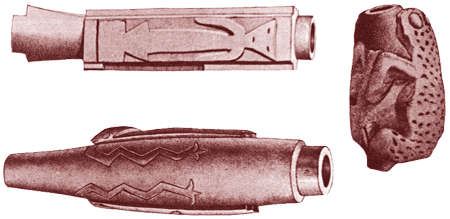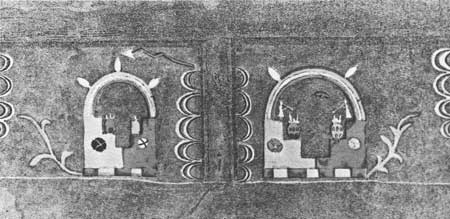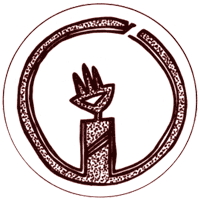

Contents Foreword Preface The Invaders 1540-1542 The New Mexico: Preliminaries to Conquest 1542-1595 Oñate's Disenchantment 1595-1617 The "Christianization" of Pecos 1617-1659 The Shadow of the Inquisition 1659-1680 Their Own Worst Enemies 1680-1704 Pecos and the Friars 1704-1794 Pecos, the Plains, and the Provincias Internas 1704-1794 Toward Extinction 1794-1840 Epilogue Abbreviations Notes Bibliography |
Father Ayeta as Deliverer The man everyone looked to for salvation was thirty-four-year-old Fray Francisco de Ayeta, a tireless Spaniard from Pamplona who took over mission supply in 1674. A decade earlier, at the insistence of the Franciscans themselves, the wagons had been surrendered to a lay contractor, ex-governor Juan Manso. Since then, the missionaries had done nothing but complain. Manso had provided one wagon for every three friars, instead of one for every two as before, and he had overloaded them with commercial cargo. He had delayed delivery, and when the caravans did finally reach New Mexico, he ordered everything dumped at San Felipe, obliging the friars to haul their own supplies from there. After considerable discussion, the crown terminated the old royal contract in favor of a lump-sum annual payment, 330 pesos for each priest and 230 for every lay brother. With the money, Procurator-general Ayeta bought wagons, mules, and the usual supplies and set out for the colony. [75] The new governor, don Juan Francisco Treviño, the cabildo of Santa Fe, and Father Ayeta, of necessity, all joined hands. New Mexico needed help, help that neither she nor her downtrodden populace could provide. Ayeta agreed to carry a petition to the viceroy. Appearing at court late in the summer of 1676, the Franciscan was convincing. Meantime the provincial chapter elected him custos. On February 27, 1677, Father Ayeta left again for the north with a caravan conveying not only the regular triennial mission supplies, but also another governor, don Antonio de Otermín; fifty convict soldiers, their commander, and their sergeant as reinforcements for New Mexico's frontiers; one hundred arquebuses; one hundred hilts for swords and daggers; fifty saddles with bridles and spurs; and one thousand horses. One epileptic convict ran away at Parral and six more at El Paso while the caravan waited for the waters to fall. The rest passed muster in the cold at Santa Fe in December 1677.
Emergency Defense Measures
Ayeta now threw himself into the business of defense. The friars must make every sacrifice. There was no talk of precedents. In the hope of making a stand, the custos, "taking the food from the mouths of my religious," ordered more than four hundred fanegas of provisions, two hundred goats, and forty head of cattle placed at the mission of Galisteo to support ten of the soldiers and all the refugees from the deserted Salinas pueblos. He arranged for another similar cache at Senecú, reestabished through "the vigilance, promptness, Christian application, and pious zeal" of Governor Otermín. And in Santa Fe, he had other mission provisions delivered for the remaining soldiers' mess, along with twenty protective leather doublets, without which "they could not go out on campaign, except in great danger." By September 1678, the indefatigable Ayeta was back in Mexico City urging another fifty men armed and outfitted as the previous ones but "omitting the thousand horses that went then and applying the three thousand pesos of their value to the maintenance of the men." Moreover, a fifty-man presidio, like the one in Sinaloa, should be established in Santa Fe at royal expense, at least for a decade. When the viceregal government forwarded Ayeta's new proposals to Spain, he loaded up the next shipment of mission supplies and headed north for a third time. Reining up at El Paso in the heat of mid-summer 1680, he found the great silty-brown river in flood. It was here on August 25 that the strong-willed friar received news from New Mexico that would have caused an Old Testament prophet to cry out in anguish and rend his garments. It had finally happened, "the disaster that has threatened so many times." Father Ayeta fell on his knees in prayer. [76] Friars and Soldiers Cooperate The calamities of the 1670s had forced the unruly Hispanic community to pull together. According to Father Ayeta, colonists and missionaries joined in grateful thanksgiving for "such a good governor" as Antonio de Otermín. The Pueblo Indians too had begun to pull together, to a degree the Spaniards would not recognize—until it was too late. Taking a page from the legendary Cortés, don Juan de Oñate had made a point of his deference to the first humble Franciscans, the servants of the Spaniards' all-powerful triune God. He had entrusted the conversion of the Pueblo Indians to them "for all time." Later governors, like Eulate, Rosas, and Peñalosa, had damned the missionaries, even bloodied their heads. Certain friars, invoking the authority of the Inquisition—Ordóñez, Perea, and Posada—had brought governors to their knees. The unedifying spectacle of jealous, eye-gouging Spaniards at one another's throats cannot have engendered respect among the long-suffering Pueblos. If the Spaniards, friars and colonists alike, were consistent in anything, it was that the mission Indians should work, produce food stuffs, and pay tribute. But even in this, they differed as to approach. Fray Pedro de Ortega smashed the objects of the Pecos' worship. Benavides ordered piles of kachina masks and prayer sticks put to the torch. Fray Andrés Juárez seemed to look the other way, so long as the children combed their hair and came to catechism. Governor López de Mendizábal commanded the natives to revive their kachina dances. Encomendero Francisco Gómez Robledo said he saw no harm in the dances. Spaniards at Galisteo undressed and joined in. Then came Fray Alonso de Posada and more bonfires. Precursors of Pueblo Revolt Father Talabán had lamented in 1669 that starving Christian Indians had turned on the friars and robbed and destroyed mission conventos. Particularly among the Piro and Salinas pueblos—where famine, disease, and Apache aggression had taken a ghastly toll—were the Pueblos showing their defiance of a regime that had brought them nothing but misery. During the administration of Fernando de Villanueva, 1665-1668, certain of the Piros rebelled,
But Clemente too was found out and hanged. When they searched his quarters, they found "a large number of idols and entire kettles full of idolatrous powdered herbs, feathers, and other trifles." [77] With the harmony of their life so obviously convulsed, it was little wonder the Pueblos sought to placate the forces that had governed their existence before the Spaniards' coming. Not that they had ever given up the old ways, but they had compromised. They had built Christian churches in their pueblos and let their babies be baptized. They had carried Christian saints in procession. Now the locusts, the disease, and the starving had been visited upon them as unmistakable signs condemning their compromise. And neither the Spaniards nor their saints seemed able to cope.
Witchcraft Trials of 1675 No one had to tell the Spaniards that Pueblo kivas were "places of idolatry where the said apostates offered to the devil the grain and other things they possess." Worse, Pueblo sorcerers killed by witchcraft. In fact, in 1675, Governor Treviño, acting on reports of witchcraft among the Tewa pueblos—the very pueblos Father Talabán had succored six years earlier—had forty-seven alleged sorcerers rounded up and brought to Santa Fe for trial. Accused of bewitching the ailing Fray Andrés Durán, guardian of San Ildefonso, and three other persons, and of having killed seven friars and three Spaniards, the men were found guilty, three were hanged—one each as an example in Nambé, San Felipe, and Jémez— one hanged himself, and the others were sentenced to lashing, prison, or servitude. Meanwhile Capt. Francisco Javier, Treviño's secretary, "gathered up many idols, powders, and other things which he took from the houses of the sorcerers and from the countryside." But this time the Pueblos called the governor's bluff. Leaving reinforcements in the hills, an armed troop of more than seventy descended on the casas reales to negotiate the release of the prisoners, or, that failing, to kill the governor. Sensing the mood of these uninvited guests, Treviño accepted their eggs and other offerings, gave them some woolen blankets, and reportedly said about the prisoners, lamely, "Wait a while, children; I will give them to you and pardon them on condition that you forsake idolatry and iniquity." [78] Fray Fernando de Velasco, guardian of the convento at Pecos in August 1680, was an old hand. Born in the ancient port city of Cádiz about 1620—the year Fray Pedro de Ortega broke up the idols at Pecos—he had taken the Franciscan habit thirty years later on August 14, 1650, at Mexico's Convento Grande. Now he was about to celebrate his thirtieth year as a friar. A missionary in New Mexico since the mid-1650s, he had seen service at all the difficult places—at Tajique and Chililí between 1659 and 1661 during the time of Nicolás de Aguilar, the Attila of New Mexico; at Ácoma in 1667; and at the Piro pueblo of Socorro during the early 1670s. By comparison, Pecos was a picnic. [79] Velasco had a young companion at Pecos, an unaffected twenty-six-year-old lay brother named Juan de la Pedrosa. Invested at the Convento Grande on May 31, 1672, Fray Juan was a native of Mexico City. He had come north with Father Ayeta in the winter of 1674-1675. [80] By Thursday, August 8, Father Velasco at Pecos knew that something was afoot. His Indians had told him that two Tewas from Tesuque had come round to announce a general uprising of all the Pueblos in league with Apaches, now set for the night of August 13. Velasco wrote immediately to Governor Otermín in Santa Fe, and the governor of the Pecos served as runner.
On Friday the ninth, Otermín had the warning from Velasco, another from Father Custos Juan Bernal at Galisteo, and a third from the alcalde mayor of Taos. All agreed. Straight-away the royal governor dispatched Francisco Gómez Robledo to pick up the two messengers from Tesuque. He alerted the other alcaldes mayores. The two Tesuques confirmed their role. They claimed that a tall black man with large yellow eyes, a representative of the Pueblo diety Pohé-yemo, had commanded all the Pueblos to rebel. The devil, said Otermín. At seven o'clock next morning, August 10, the feast of San Lorenzo, the governor recognized his error. This, not the thirteenth, was the day of reckoning. A friar who had left Santa Fe at dawn to say Mass in Tesuque had already been murdered. Father Velasco had set out from Pecos for Galisteo. The rebels fell on him in a field within sight of his destination, where the naked bodies of Father Custos Bernal, two other friars, and a number of Spanish men, women, and children stared grotesquely without seeing. Back at Pecos, young Fray Juan de la Pedrosa, two Spanish women, and three children lay dead. [81] After eighty years of submissive resentment, the Pueblos had finally gone for the jugular.
| ||||||||
 Top Top
|
| ||||||||








